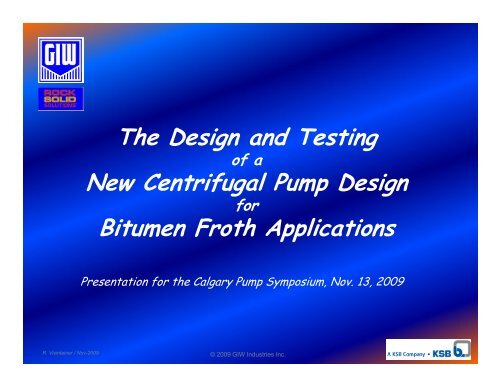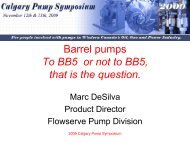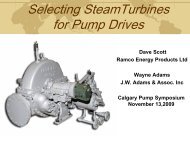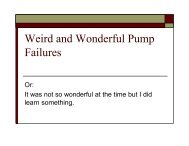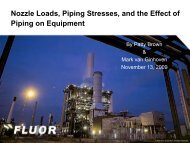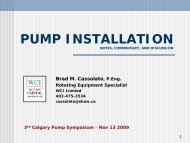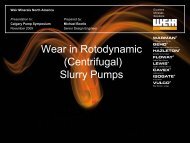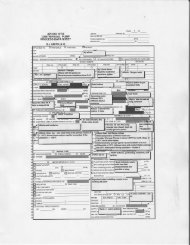Download PDF - Calgary Pump Symposium
Download PDF - Calgary Pump Symposium
Download PDF - Calgary Pump Symposium
Create successful ePaper yourself
Turn your PDF publications into a flip-book with our unique Google optimized e-Paper software.
The Design and Testing<br />
of a<br />
New Centrifugal <strong>Pump</strong> Design<br />
for<br />
Bitumen Froth Applications<br />
Presentation for the <strong>Calgary</strong> <strong>Pump</strong> <strong>Symposium</strong>, Nov. 13, 2009<br />
R. Visintainer / Nov-2009<br />
© 2009 GIW Industries Inc.
Froth and Viscous<br />
Losses<br />
s<br />
2 © 2009 GIW Industries<br />
R. Visintainer
Bitumen Froth Losses – Head (Pressure)<br />
Summary of the primary<br />
losses in viscous froth and<br />
the factors affecting them.<br />
Clear water: pump<br />
design & speed.<br />
Viscosity effect:<br />
bitumen properties,<br />
temperature.<br />
Density effect: % air.<br />
Airlock: % air, viscosity,<br />
froth properties, flowrate,<br />
system & pump design.<br />
3 © 2009 GIW Industries<br />
R. Visintainer
Bitumen Froth Losses – NPSHR<br />
Summary of the primary<br />
losses in viscous froth and<br />
the factors affecting them.<br />
Clear water: pump<br />
design & speed.<br />
Viscosity effect:<br />
bitumen properties,<br />
temperature.<br />
Density effect: % air.<br />
Airlock: % air, viscosity,<br />
froth properties, flowrate,<br />
system & pump design.<br />
4 © 2009 GIW Industries<br />
R. Visintainer
Strategies for Improving Froth <strong>Pump</strong> Performance<br />
Improve suction inlet conditions:<br />
<br />
Increase NPSHA<br />
<br />
Decrease % air<br />
<br />
Increase pump inlet diameter<br />
Increase pump head without increasing speed:<br />
<br />
Increase impeller diameter<br />
<br />
High head impeller design<br />
Control airlock:<br />
<br />
Adjust froth properties<br />
<br />
Prevent (or delay) airlock formation<br />
<br />
Airlock venting<br />
Focus of this research project.<br />
5 © 2009 GIW Industries<br />
R. Visintainer
Test Setup<br />
6 © 2009 GIW Industries<br />
R. Visintainer
Froth Test Rig – GIW Hydraulic Lab<br />
7 © 2009 GIW Industries<br />
R. Visintainer
Froth Test Rig – Sparger Design<br />
8 © 2009 GIW Industries<br />
R. Visintainer
Froth Test Rig – Clear Suction Spool<br />
9 © 2009 GIW Industries<br />
R. Visintainer
Froth Test Rig – Testing Parameters<br />
• Viscosity:<br />
o<br />
o<br />
1 cSt (water)<br />
500 to 10,000 cSt (corn syrup)<br />
• Air: 0% to 30%<br />
• Flow: 1000<br />
– 3000 m 3 /hr<br />
• Head: 10 to 60 m<br />
• Speed: 300 to 800 rpm<br />
• Suction pressure: 0.0 to 1.0 atm<br />
10 © 2009 GIW Industries<br />
R. Visintainer
Airlock<br />
11 © 2009 GIW Industries<br />
R. Visintainer
Airlock – Low Re Number (laminar)<br />
Airlock forms as elongated<br />
bubble in suction piping.<br />
12 © 2009 GIW Industries<br />
R. Visintainer
Airlock – High Re Number (turbulent)<br />
Notice density difference<br />
between froth in impeller<br />
passages and casing.<br />
Also formation of airlock<br />
bubble in suction.<br />
13 © 2009 GIW Industries<br />
R. Visintainer
Airlock – Some Typical Results<br />
airlock<br />
14 © 2009 GIW Industries<br />
R. Visintainer
Airlock – Some Typical Results<br />
15 © 2009 GIW Industries<br />
R. Visintainer
Airlock – Some Typical Results<br />
16 © 2009 GIW Industries<br />
R. Visintainer
Airlock – Some Typical Results<br />
17 © 2009 GIW Industries<br />
R. Visintainer
“Excess Air” Concept – Suction Inlet Coalescence<br />
Onset of airlock coincides with<br />
appearance of coalesced air in<br />
suction piping.<br />
18 © 2009 GIW Industries<br />
R. Visintainer
Strategies for Controlling Airlock<br />
Adjust froth properties:<br />
<br />
Decrease % air in the process<br />
<br />
Increase suction inlet velocity (works against improved<br />
NPSHR)<br />
<br />
Prevent “excess” air from reaching the suction inlet<br />
(improved design of sumps and launders)<br />
Prevent (or delay) airlock formation:<br />
<br />
Airlock disturbance (open shrouded designs)<br />
<br />
Improved NPSHR performance<br />
<br />
High head impeller design<br />
Focus of this research project.<br />
Airlock venting:<br />
<br />
Suction inlet venting (removes coalesced air)<br />
<br />
Internal pump venting<br />
19 © 2009 GIW Industries<br />
R. Visintainer
Airlock Venting System<br />
20 © 2009 GIW Industries<br />
R. Visintainer
Airlock Venting System<br />
excess air<br />
P SUCTION > P VENT<br />
froth<br />
Suction pressure must exceed vent pressure<br />
(usually atmospheric) by at least 10 kPa<br />
excess air<br />
froth<br />
21 © 2009 GIW Industries<br />
R. Visintainer
Airlock Venting System<br />
Vent pipe: Use hard pipe with heat<br />
strips in bitumen applications.<br />
22 © 2009 GIW Industries<br />
R. Visintainer
Airlock Venting System – Some Typical Results<br />
vent closed,<br />
typical airlock losses<br />
vent opened,<br />
airlock losses controlled<br />
23 © 2009 GIW Industries<br />
R. Visintainer
Airlock Venting System – Some Typical Results<br />
24 © 2009 GIW Industries<br />
R. Visintainer
Airlock Venting System – Viscous Froth<br />
OPERATION OF AIR VENT - AIR LOCK REMOVAL<br />
500-700 rpm, 3000 m3/hr, corn syrup at approx 3,000 cSt, 15% air plus 5% excess air added at sparger<br />
Airlock venting<br />
25 © 2009 GIW Industries<br />
R. Visintainer
High Head<br />
Impeller Design<br />
26 © 2009 GIW Industries<br />
R. Visintainer
High Head vs. Conventional Designs<br />
Summary of the primary<br />
losses in viscous froth and<br />
the factors affecting them.<br />
Clear water: pump<br />
design & speed.<br />
Viscosity effect:<br />
bitumen properties,<br />
temperature.<br />
Conventional design<br />
(without venting)<br />
Density effect: % air.<br />
Airlock: % air, viscosity,<br />
froth properties, flowrate,<br />
system & pump design.<br />
27 © 2009 GIW Industries<br />
R. Visintainer
High Head vs. Conventional Designs<br />
Advantage of High Head<br />
design operating at same<br />
speed and NPSHR.<br />
High Head design<br />
(with venting)<br />
High Head design<br />
(without venting)<br />
Clear water: pump<br />
design & speed.<br />
Viscosity effect:<br />
bitumen properties,<br />
temperature.<br />
Density effect: % air.<br />
Airlock: % air, viscosity,<br />
froth properties, flowrate,<br />
system & pump design.<br />
28 © 2009 GIW Industries<br />
R. Visintainer
High Head Impeller Design – CFD Analysis<br />
CFD analysis used to<br />
optimize NPSHR<br />
performance.<br />
HIGH SUCTION SIDE VELOCITY<br />
@ SHOCKLESS DESIGN FLOWRATE ENTRY<br />
NEGATIVE NPSHR IMPACT<br />
29 © 2009 GIW Industries<br />
R. Visintainer
High Head Impeller Design – CFD Analysis<br />
Turbulence<br />
helps to disturb<br />
airlock formation<br />
Conventional Closed Shroud Design<br />
Expanded, Open Shrouded Design<br />
30 © 2009 GIW Industries<br />
R. Visintainer
High Head Impeller Design – CFD Analysis<br />
Higher head = more<br />
gas compression<br />
Conventional Closed Shroud Design<br />
Expanded, Open Shrouded Design<br />
31 © 2009 GIW Industries<br />
R. Visintainer
High Head vs. Conventional Designs<br />
Some sacrifice in Efficiency<br />
Increased Head<br />
Improved NPSHR<br />
at higher flows<br />
32 © 2009 GIW Industries<br />
R. Visintainer
High Head vs. Conventional Designs<br />
33 © 2009 GIW Industries<br />
R. Visintainer
High Head Impeller NPSHR Performance<br />
Variable speed NPSHR testing<br />
ti<br />
Water froth - 0.03% soap<br />
100% BEPQ<br />
600 - 810 rpm<br />
34 © 2009 GIW Industries<br />
R. Visintainer
Viscous<br />
Effects<br />
35 © 2009 GIW Industries<br />
R. Visintainer
Viscous Froth Simulation<br />
Corn syrup at 3,000 cSt<br />
36 © 2009 GIW Industries<br />
R. Visintainer
Viscous Froth Simulation<br />
Corn syrup froth at 15% air<br />
and 3,000 cSt<br />
37 © 2009 GIW Industries<br />
R. Visintainer
Viscous Testing and Analysis – Typical Results<br />
Viscosity<br />
Correlations<br />
HEAD<br />
1,000 to 10,000000 cSt<br />
10-15% air<br />
0% excess air<br />
0.05 to 0.1 atm Ps<br />
scaled to 700 rpm<br />
38 © 2009 GIW Industries<br />
R. Visintainer
Viscous Testing and Analysis – Typical Results<br />
Viscosity<br />
Correlations<br />
FLOW<br />
1,000 to 10,000000 cSt<br />
10-15% air<br />
0% excess air<br />
0.05 to 0.1 atm Ps<br />
scaled to 700 rpm<br />
39 © 2009 GIW Industries<br />
R. Visintainer
Viscous Testing and Analysis – Typical Results<br />
Viscosity<br />
Correlations<br />
EFFICIENCY<br />
1,000 to 10,000000 cSt<br />
10-15% air<br />
0% excess air<br />
0.05 to 0.1 atm Ps<br />
scaled to 700 rpm<br />
40 © 2009 GIW Industries<br />
R. Visintainer
Viscous Testing and Analysis – Typical Results<br />
Viscosity<br />
Correlations<br />
POWER<br />
1,000 to 10,000000 cSt<br />
10-15% air<br />
0% excess air<br />
0.05 to 0.1 atm Ps<br />
scaled to 700 rpm<br />
41 © 2009 GIW Industries<br />
R. Visintainer
Key<br />
Learnings<br />
42 © 2009 GIW Industries<br />
R. Visintainer
Key Learnings<br />
• Given enough air, the pump will airlock.<br />
• The “Excess Air” concept:<br />
‣ Airlock occurs when the liquid is carrying more air than it can hold.<br />
‣ For conventional designs in clear water: 3% to 5%.<br />
‣ Depending on composition of froth, can increase to 40% or more.<br />
• Airlock can be delayed by…<br />
‣ … airlock venting systems (requires suction pressure > atmospheric).<br />
‣ … high head impeller designs adjusted for good NPSHR performance.<br />
• High head impeller design can improve froth pump performance by…<br />
‣ … reducing operating speed thus improving NPSHR performance.<br />
‣ … more airlock disturbance.<br />
‣ … better air compression within the impeller.<br />
43 © 2009 GIW Industries<br />
R. Visintainer
Questions<br />
&<br />
Discussion<br />
44 © 2009 GIW Industries<br />
R. Visintainer


